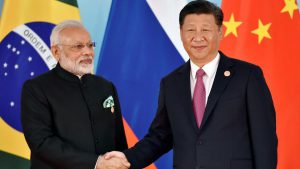
Picture Courtesy: Hindustan Times
On the occasion of BRICS 2017, India’s leading think tank -Observer Research Foundation (ORF) releases a collection of essays delving into the possible areas of BRICS collaboration. This volume, edited by ORF’s Vice President Samir Saran, has written, studied and contributed to the development of the group since 2008. In this backdrop, Impact News is publishing the Note after approval from the Editor.
Editor’s Note
By Samir Saran
Vice President, ORF
The formation of BRICS was an unprecedented and unlikely event in history. Originally conceived as a handy acronym describing the emerging economies of the world, the economic term came into being as a political entity in 2006, on the sidelines of the United Nations General Assembly. The foreign ministers of Brazil, Russia, India, and China met during the conference and agreed to bring their respective heads of state together for annual summits to discuss shared political and economic interests. The inaugural summit meeting of the grouping, held in Yekaterinburg on June 16, 2009, was characterised by productive dialogue and a strengthening of relations. Subsequent meetings inspired a note-worthy addition to the coalition in 2011, as South Africa was invited to join, bringing the BRICS grouping to its full standing. Observers of the geo-political world order have long espoused the refrain that BRICS is characterised by three I’s – Ideology, Issues, and Institutions. Yet, the group’s inception did not necessarily come about as result of common ideology – each nation had varying motivations dictating their decision to enter into the grouping. Russia, rising from the ashes of the Soviet Union, viewed the possible alliance as a mechanism to bring change to the global governance architecture dominated by the US and its allies. China deemed the formation of the coalition a key measure in furthering its economic and political ambitions. Brazil saw BRICS as a vehicle through which it could transform itself from a regional power to a global power. South Africa, moving on from the ignominy associated with apartheid, needed the grouping to legitimise its standing in the world as the tallest leader in Africa. India saw BRICS as a ladder that would allow it to make the jump from the geo-economic assembly line to the high table of global management. Despite the divergent rationales behind each member’s motivation for joining the alliance, there remained some commonalities. The embedded power structures within the Western hemisphere were a key driver of aggregation for BRICS. Each member of the coalition believed that the existing global governance institutions did not allow them the influence due to them. Yet, none of the countries were capable of asking for significant change by themselves. They came to the realisation they needed an entente that would force a more inclusive governance architecture. These were the foundational drivers that led to the creation of this group. Moreover, even as these five countries came together, there were two ideals around which BRICS would organise their cooperation. First, each nation’s sovereignty would be paramount within the power structures of the world. Second, each state would seek greater democracy in the international decision-making process, regardless of domestic regimes.
“To survive, BRICS must shift focus towards institutions and issues.”
As we approach the first decade of BRICS, the ideological incoherence among its members is apparent, as each nation continues to pursue its own agenda. Russia has capitalised on the malaise that plagued Europe and the United States after the 2009 financial crisis, positioning itself as the most important political player in the Middle East and perhaps even in Europe. Brazil and South Africa have succumbed once again to internal strife, as economic woes and systemic corruption force them to turn their focus inward. The divergent ideologies of the member states are perhaps most evident in the current border standoff between India and China as the latter’s ambitions to dominate Asia becomes apparent. The proposed China-Pakistan Economic Corridor (CPEC) provides further indications of China’s bid to ride roughshod over India’s sovereign concerns. Given the contemporary reality, it seems that BRICS nations will be unable to agree on a common political ideology. Therefore, in order for the alliance to survive, the focus must be shifted to the remaining two I’s – Institutions and Issues. To manage the paradox of geopolitical tensions and mutually beneficial prospects, a greater focus must be placed on cooperating on key issues important to each nation and the continued institutionalisation of the grouping. The creation of affiliated organisations and bodies such as the New Development Bank and a convergence on matters significant to all five member nations will allow members to pursue sovereign interests while still permitting for the continued existence of the BRICS vehicle.
This volume, featuring commentary from pre-eminent scholars and emerging next generation researchers, attempts to put forward measures that can separate and insulate the group from the vagaries of international discord.
For More on A Decade of BRICS: Indian Perspectives for the Future, Click Here


















